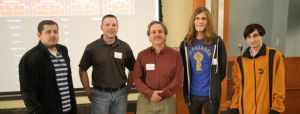
Brookdale Community College Engineering & Technology Professor Michael Qaissaunee brings a fine-tuned awareness of students’ needs and strong commitment to educational equity to his work as an Advanced Technological Education (ATE) principal investigator.
Qaissaunee received the 2020 HI-TEC Educator of the Year Award for his development of electronic textbooks for technician education and web-based interactive explainers that have lowered students’ costs and increased their understanding of complex science, technology, engineering and math (STEM) concepts.
“These have really made a difference in my classroom and I’ve heard from teachers from across the country that … these animated learning snippets and interactive activities have really transformed their classrooms. It has really enabled us to reach a broader diversity of learners. They’ve provided a great teaching environment and enabled students to master content and skills that they’re studying,” John Sands said in his introduction of Qaissaunee at the 2020 HI-TEC Conference awards ceremony. Sands is principal investigator of the National Support Center for Systems Security and Information Assurance and a subject matter expert on Qaissaunee’s E-MATE 2.0: Building Capacity for Interactive Teaching and Learning (Award # 1601612) ATE grant.
Many of the 50 E-MATE interactives on electronics, networking, and cybersecurity topics that Qaissaunee and Sands and his team have built are available at Brookdale’s STEM Institute; all of them will eventually be posted on CSSIA’s website. Other Brookdale College departments are the current hosts of E-MATE interactives that cover challenging concepts in chemistry, environmental science, and physics.
All the E-MATE interactives are free, and, because they use HTML5, do not require an internet connection nor Flash nor Java software. Educators and students can download and access them from flash drives, which, pre-COVID, Qaissaunee distributed at conference presentations and now sends to people who contact him at mqaissaunee@brookdalecc.edu.
Jaime Mahoney, professor of Computer Information Technology at Bunker Hill Community College, led another of the E-MATE 2.0 teams that Qaissaunee said has “tested the boundaries of what we thought we could do” by building interactive escape rooms for ethical hacking. Students build cybersecurity skills and earn points by decoding hidden messages in a capture-the-flag game in the virtual environment. “Jaime Mahoney from Bunker Hill is very creative, comes up with some really clever ideas,” Qaissaunee said.
In addition to wrapping up work on E-MATE 2.0, Qaissaunee is principal investigator of Collaborative Research: Community College Accelerated CyberCorps Pilot Program (Award #1842074) that aims to increase the placement of community college graduates in government cybersecurity positions. He is also involved in a National Security Administration teacher-preparation initiative that aims to build cybersecurity career interest among elementary and secondary school students.
In March, four students who took at least one of his networking courses were among the 104 qualifiers for the in-person competition of the NJ Governor’s Cyber Security Challenge. The competition began online with 600 participants. The competition uses NetWars, which the U.S. military, federal agencies, and businesses use to evaluate and train cyber warriors.
In the photo, Qaissaunee is with Brookdale students (from left) Flamur “Tony” Bomova, who finished in 36th place; Keith Novak, who finished in 28th place; Colin Mahns, who finished in 11th place; and Christian Nicholson, who finished in 19th place.
ATE at Core of His Career
This summer, while in his seventeenth year as chair of the Engineering and Technology Department, Qaissaunee found the time to formulate another ATE grant proposal.
“ATE is sort of the core of what I’ve done in terms of my career,” Qaissaunee said, recalling that his first ATE grant application was “borderline.” He did not know this until one evening in 2003 when Gerhard Salinger, then co-lead program director of ATE, telephoned to suggest that he call Gordon Snyder to see if he would collaborate on the proposed project. Snyder, then principal investigator of the National Center for Telecommunications Technologies (NCTT), readily agreed to help Qaissaunee with his project to add wireless communications to an existing Electronics Engineering Technology AAS degree and create new programs with multiple entrance and exit points for technicians.
It was the first of many ATE collaborations for Qaissaunee that have resulted in new curricula and e-textbooks.
E-textbooks were a novelty when he first obtained funding to create them for STEM technician courses to save students money. Within a few years he was creating large e-textbooks for the National Center for Optics and Photonics Education (OP-TEC) and the National Center for Supply Chain Automation.
He then saw an opportunity to help faculty teach students difficult concepts by adding animation to the illustrations in the e-textbooks for interactive modules that could be dropped into existing courses. “This was a way to engage them [students] and give them something they could view on a tablet, on a Smartphone, on a computer. It was cross-platform,” he said.
For years Qaissaunee has been an ATE booster who encourages his colleagues to submit ATE grant proposals.
“I tell people at my college, as they get grants, it’s a lot of work. Grants are a lot of work, but it’s such a rich vibrant community and really great, generous people that you meet, that any time I can go to these [grant-related] conferences I come back sort of recharged and excited to get back into the classroom and teach again. You get a lot of validation from this community. ATE in particular has been that for me over these last 17 years,” he said.

 Subscribe
Subscribe


 See More ATE Impacts
See More ATE Impacts

Comments
There are no comments yet for this entry. Please Log In to post one.